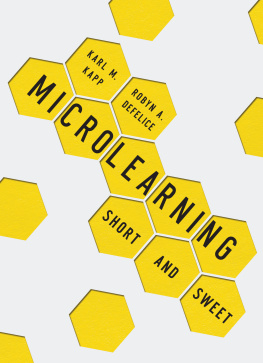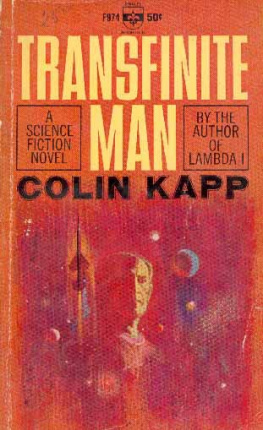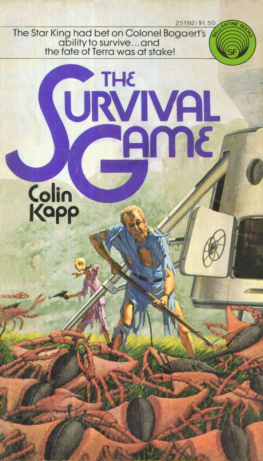Karl M. Kapp - Microlearning: Short and Sweet
Here you can read online Karl M. Kapp - Microlearning: Short and Sweet full text of the book (entire story) in english for free. Download pdf and epub, get meaning, cover and reviews about this ebook. year: 2019, publisher: Association for Talent Development, genre: Romance novel. Description of the work, (preface) as well as reviews are available. Best literature library LitArk.com created for fans of good reading and offers a wide selection of genres:
Romance novel
Science fiction
Adventure
Detective
Science
History
Home and family
Prose
Art
Politics
Computer
Non-fiction
Religion
Business
Children
Humor
Choose a favorite category and find really read worthwhile books. Enjoy immersion in the world of imagination, feel the emotions of the characters or learn something new for yourself, make an fascinating discovery.
- Book:Microlearning: Short and Sweet
- Author:
- Publisher:Association for Talent Development
- Genre:
- Year:2019
- Rating:5 / 5
- Favourites:Add to favourites
- Your mark:
- 100
- 1
- 2
- 3
- 4
- 5
Microlearning: Short and Sweet: summary, description and annotation
We offer to read an annotation, description, summary or preface (depends on what the author of the book "Microlearning: Short and Sweet" wrote himself). If you haven't found the necessary information about the book — write in the comments, we will try to find it.
Microlearning: Short and Sweet — read online for free the complete book (whole text) full work
Below is the text of the book, divided by pages. System saving the place of the last page read, allows you to conveniently read the book "Microlearning: Short and Sweet" online for free, without having to search again every time where you left off. Put a bookmark, and you can go to the page where you finished reading at any time.
Font size:
Interval:
Bookmark:


2019 ASTD DBA the Association for Talent Development (ATD)
All rights reserved. Printed in the United States of America.
22 21 20 19 1 2 3 4 5
No part of this publication may be reproduced, distributed, or transmitted in any form or by any means, including photocopying, recording, information storage and retrieval systems, or other electronic or mechanical methods, without the prior written permission of the publisher, except in the case of brief quotations embodied in critical reviews and certain other noncommercial uses permitted by copyright law. For permission requests, please go to www.copyright.com, or contact Copyright Clearance Center (CCC), 222 Rosewood Drive, Danvers, MA 01923 (telephone: 978.750.8400; fax: 978.646.8600).
ATD Press is an internationally renowned source of insightful and practical information on talent development, training, and professional development.
ATD Press
1640 King Street
Alexandria, VA 22314 USA
Ordering information: Books published by ATD Press can be purchased by visiting ATDs website at www.td.org/books or by calling 800.628.2783 or 703.683.8100.
Library of Congress Control Number: 2019945544
ISBN-10: 1-949036-73-1
ISBN-13: 978-1-949036-73-2
e-ISBN: 978-1-949036-74-9
ATD Press Editorial Staff
Director: Sarah Halgas
Manager: Melissa Jones
Community of Practice Manager, Learning Technologies: Justin Brusino
Developmental Editor: Jack Harlow
Text Design: Michelle Jose and Shirley E.M. Raybuck
Cover Design: Faceout Studio, Spencer Fuller
Printed by Data Reproductions Corporation, Auburn Hills, MI
At first, the notion of writing a book on microlearning was a bit preposterous. Shouldnt we just apply the microlearning concept we are writing about to develop the material? After all, isnt a book something you sit down and read over the course of several hours? If you had to make the comparison, that feels more like a full-length training program. Why wouldnt we chunk the content into tiny portions, convert to PowerPoint slides, add some narration, and post it online? Isnt that what microlearning is all about?
Well, to be honest, no. Thats why we decided a book was needed to demystify what microlearning really is, to offer all the learning theories and research that support it, and to present an actionable road map for planning, implementing, designing, and evaluating it.
All learning approaches need defined foundations, valid theory and research to support the method, and a look at the development process from analysis through to evaluation. We know microlearning is trending, and many are enthusiastic to adopt it. However, we also get that not everyone knows how or why to use microlearning. And even more important is to ask, should they?
Today, there is little that provides the comprehensive background necessary to make informed training design decisions about microlearning. In doing our research, we found nuggets of great information on the topic, but not a comprehensive guidebook to assist in making those efforts actionable.
We wouldnt implement an entirely new approach to learning without doing the upfront research or perhaps a pilot to determine its value for our organization or client. Why would you do that with microlearning? Thats why we wrote this book, to provide that beginning for you.
Microlearning may seem like just another item to put in the instructional designers (IDs) toolkit; use sound instructional design practices, plan the initiative, and off you go! However, that method may only work for a small minority of IDs. With any learning approach, there are nuances you must recognize because they alter our standard methods of developing learning. Microlearning is no different.
For example, the idea that microlearning is a quick and easy way to jazz up a stale learning program is a bit of a myth. Microlearning can actually take just as long, if not more time, to develop and implement. This is because microlearning is typically distributed over a period of time. If thats not what your organization does for standard implementation, it may woefully underestimate the resources necessary for executing the solution. Its not always as simple as uploading a program into a learning management system (LMS) and providing notice of a new course. It could take time every week, month, or business quarter to create and launch the microlearning initiative your organization created.
What we are saying is that microlearning needs as much attention from an instructional design standpoint as any other form of training. Keeping this in mind will help keep microlearning from being another learning trend your company attempted to adopt but failed. If this has happened, we hope this book provides the confidence you need to give microlearning a much deserved second try!
Microlearning: Short and Sweet is designed to accommodate the novice through to the pros. The practical approach to the topics provides an opportunity to pick and choose what you need to answer your most immediate questions on the subjector to dive deeper to gain a more comprehensive understanding.
No matter your level of familiarity with microlearning concepts, we encourage all readers to start with . We not only provide examples of microlearning, but we dive into what microlearning is and is not to help clear up any misconceptions. Additionally, weve compiled several definitions of what microlearning is and developed a common set of characterizations that allowed us to operationalize a standard definition. Reviewing this chapter first, whether youre tenured in training development or new to the topic, ensures that as you read other chapters you have the appropriate context.
Now, from there it depends on what you are seeking to know or do. If you are a traditionalist in reading books, the layout of the chapters provides a logical path through the subject matter. offers a primer on microlearning from a why it works and when to use it perspective. Having an idea of what you are hoping to teach, train, develop, and so on in the back of your head while you read these chapters will help you visualize which principles and practices will work best for your subject matter.
get to the hands dirty part of microlearning: creating, designing, implementing, and evaluating microlearning products. To help elaborate the key concepts of each chapter, we have woven in case studies that were generously shared by peers leading the way in microlearning. There are a lot of folks out there doing great things with microlearning, and each case exemplifies points we make throughout the book.
With each of these chapters we look at the design and development process, not only from its impact on the learner, but also its impact on the learning developer. Our years in the field have taught us that we must be realists about what we can do as learning development professionals, given the organizational constraints and interdependencies were presented with. We want the best for our learners, but as the developers, we know we must work under certain constraints.
We conclude the book with a recap of the key takeaways from each chapter and then take a brief look at what the future may have in store for microlearning design and development.
We hope this book fuels your creative mind to see the endless possibilities for microlearning in your organization.
Font size:
Interval:
Bookmark:
Similar books «Microlearning: Short and Sweet»
Look at similar books to Microlearning: Short and Sweet. We have selected literature similar in name and meaning in the hope of providing readers with more options to find new, interesting, not yet read works.
Discussion, reviews of the book Microlearning: Short and Sweet and just readers' own opinions. Leave your comments, write what you think about the work, its meaning or the main characters. Specify what exactly you liked and what you didn't like, and why you think so.












